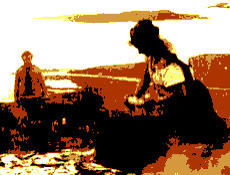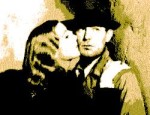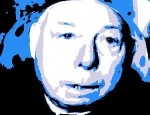Film Review
Man's physical and spiritual connection with the natural world is a
defining characteristic of the work of Swedish film director Victor
Sjöström.
Nowhere is this more evident than in his
silent masterpiece
The Outlaw and
His Wife (a.k.a.
Berg-Ejvind
och hans hustru), an inspired naturalistic rendering of the 1911
play
Fjalla-Eyvindur by
Icelandic playwright Jóhann Sigurjónsson. As in his
previous film
A Man There Was (1917),
Sjöström both directs and assumes the lead role in a powerful
redemption saga in which a majestic Scandinavian setting becomes the
driving protagonist in the drama. The similarities between these
two films is striking but what connects them most is the sublime
artistry of Sjöström's cinematographer, Julius Jaenzon.
Like the landscapes of the German romantic painter Caspar Friedrich,
Jaenzon's photography is so intensely expressive that it endows the
wild location with a soul, and rarely in a film of this era is the
natural world represented with so much heartaching beauty and awesome
might.
The Outlaw and His Wife
possesses a realism and modernity that is striking even for those who
are familiar with Sjöström's work. This shows not only
in Jaenzon's near-documentary style of photography but also in the
authentic character portrayals.
Each of the protagonists in the
drama is a fully developed human being who behaves exactly as a
psychologically complex being should behave, his or her striving for
personal happiness constantly at odds with those internal and external
forces that decide an individual's destiny. In one horrific
scene, the heroine is driven to throw her baby daughter over the edge
of a precipice. Sjöström doesn't dwell on this - it is
merely a woman's instinctive reaction to a crisis that she is presented
with, a moment of madness of the kind to which humanity is prone.
In another scene, one character contemplates murder - his crisis of
conscience is powerfully expressed through a combination of inspired
editing and deft camerawork.
There is also an intense lyrical quality to this film, carried by the
stunning mountain views that are barely contained by the physical
dimensions of the frame. Jaenzon gives the film an almost
ethereal, fairytale quality by frequently arranging shots with the sun
in the background, overexposing the film and bathing the protagonists
in an eerie glow. Long shots with the characters silhouetted
against the mountain are a constant reminder of how small they are,
completely dwarfed by their surroundings, mere ants in the hand of a
benign but capricious giant. You feel sure that the classic
American western owes a great deal to this film, particularly in the
way that the location becomes a living part of the fabric of the
narrative, not merely a pretty backdrop.
The Outlaw and His Wife is not
just about man's relation to nature, it is also a brutally honest
dissection of the relationship between a man and his wife. The
final passage of the film, depicting the titular protagonists in the
bleak winter of their marriage, might well have been written and filmed
by Sjöström's eminent successor, Ingmar Bergman. As in
Bergman's
Scenes from a Marriage (1973),
the husband and wife appear to have arrived at the end of their
relationship and are seen struggling to comprehend what has become of
their erstwhile love. Worn down by age and adversity, they have
grown contemptuous of one another and resort to hurling abuse at each
other between bouts of sickening self-pity. With the account of
their idyllic early life together still fresh in our minds, these last
scenes have a crushing cruelty to them. (Victor
Sjöström, who plays the main character Ejvind, would marry
his on-screen wife Edith Erastoff four years after making this
film.) The final shot, in which the husband and wife are
reconciled in death, is quite possibly the most viscerally poignant in
Sjöström's entire oeuvre, and so emblematic of his uniquely
rugged, Friedrich-esque form of romanticism.
© James Travers 2014
The above content is owned by frenchfilms.org and must not be copied.
Film Synopsis
Iceland, in the mid-18th century. Kari is an itinerant labourer
who persuades a wealthy widow, Halla, to give him work on her
farm. Halla is being pressurised by her brother-in-law, a feared
local bailiff, to marry him. Knowing that the bailiff is only
after her land Halla refuses him and ends up falling in love with
Kari. The bailiff then discovers that Kari is an escaped prisoner
named Ejvind, who was sent to prison for stealing a sheep. When
she hears of this, Halla confronts Kari and he admits that he is a
fugitive from justice, his one crime being to steal food to keep his
family alive during a cold winter. Instead of sending Ejvind
away, as the bailiff insisted, Halla decides to elope with him to the
mountains, where they live as man and wife according to the laws of
nature, not man. Five years later, the couple has a baby daughter
and are joined by one of Halla's former farmhands, Arnes, who has also
become an outlaw. For a while, the three people live together
quite happily, until Arnes discovers that he is violently attracted to
Halla. How easy it would be for Ejvind to meet with a fatal accident...
© James Travers
The above content is owned by frenchfilms.org and must not be copied.



